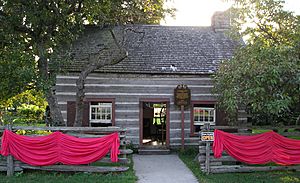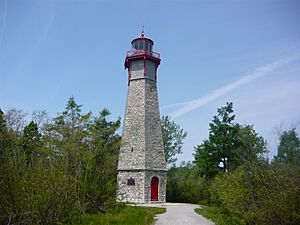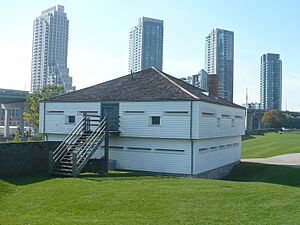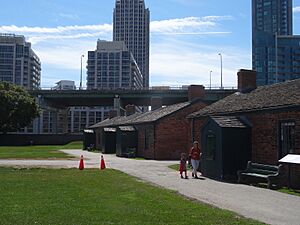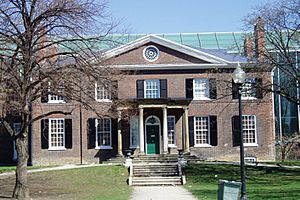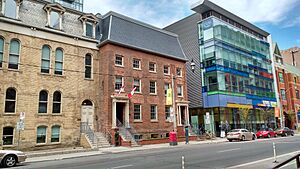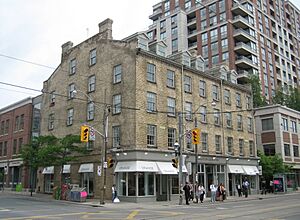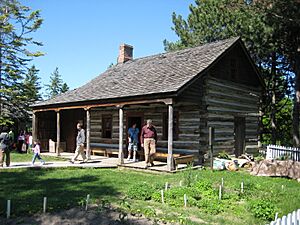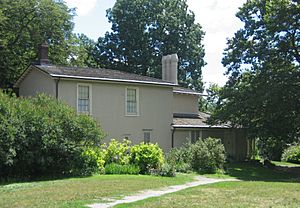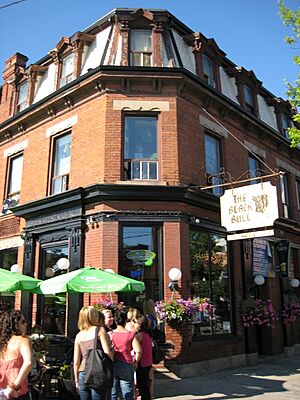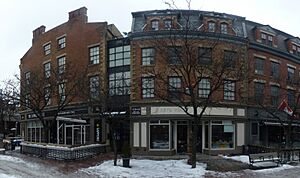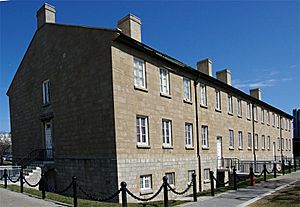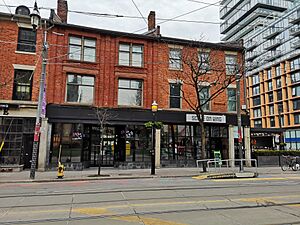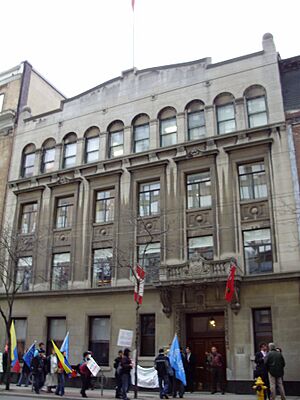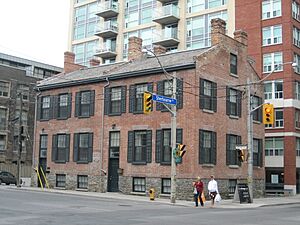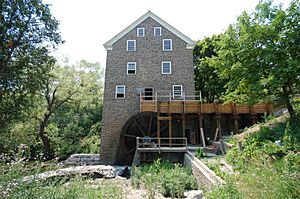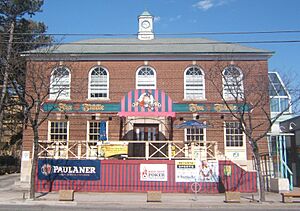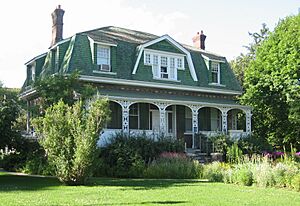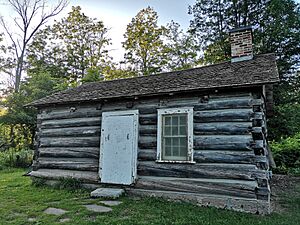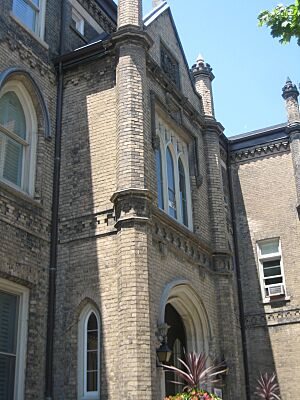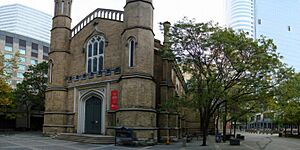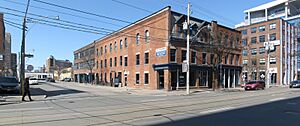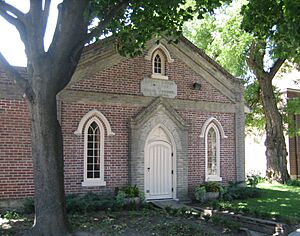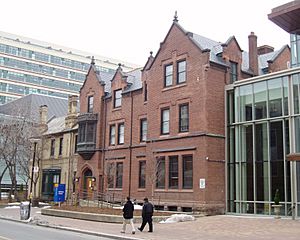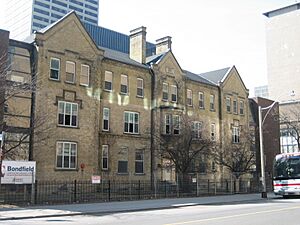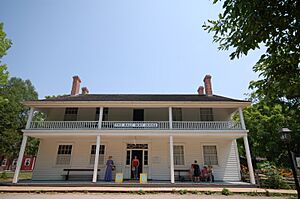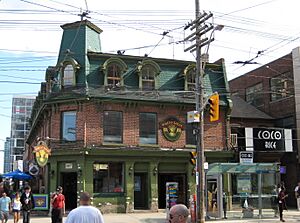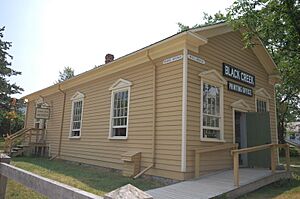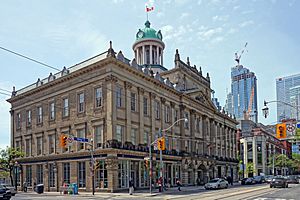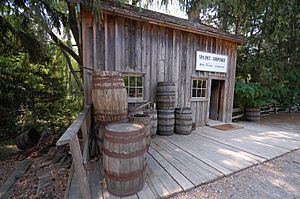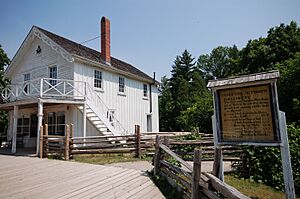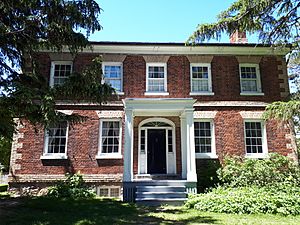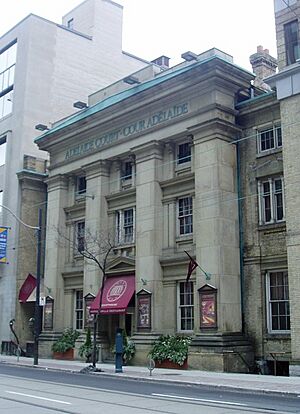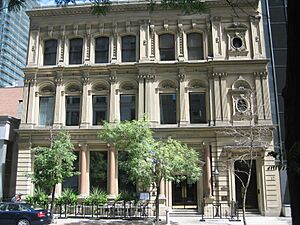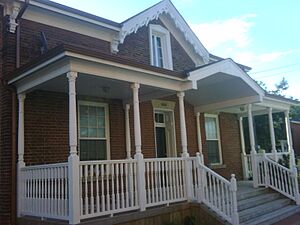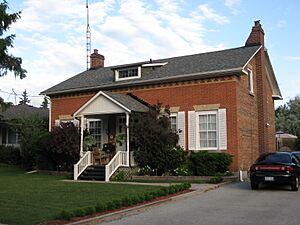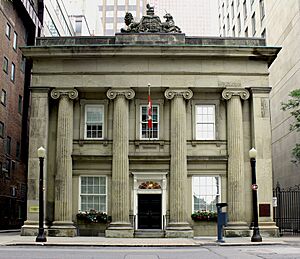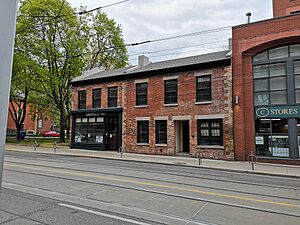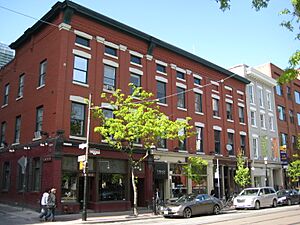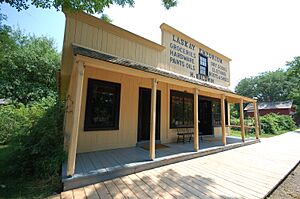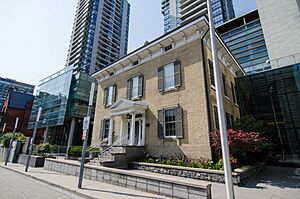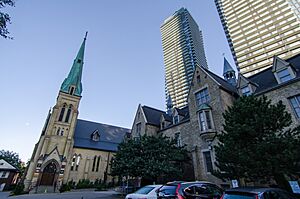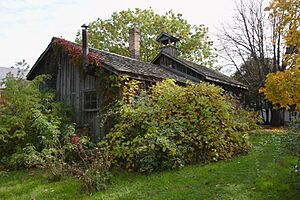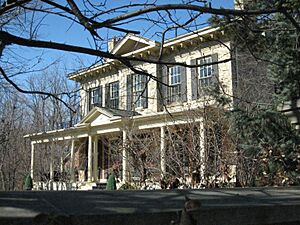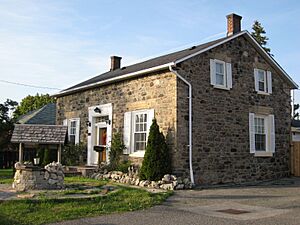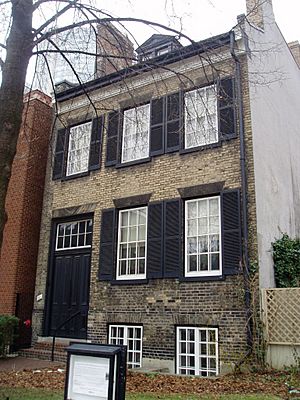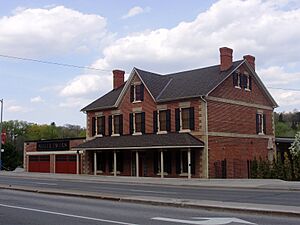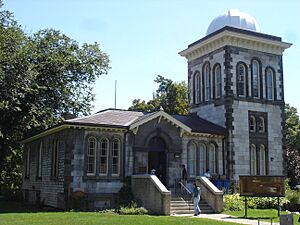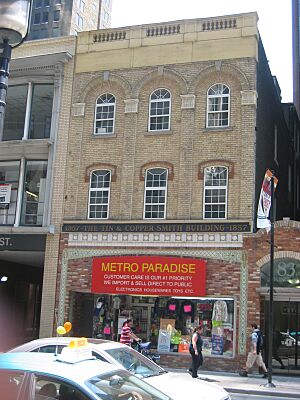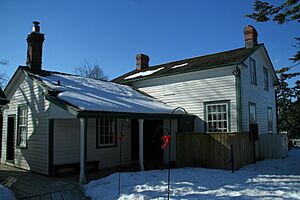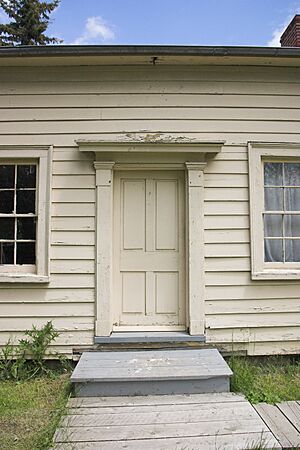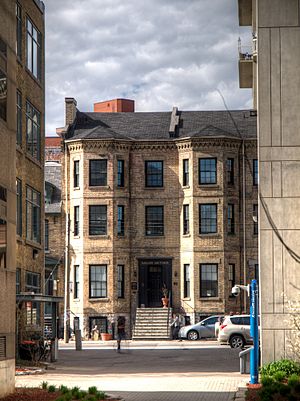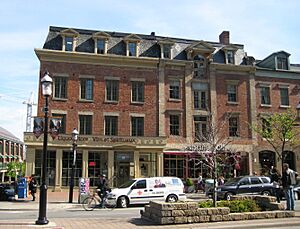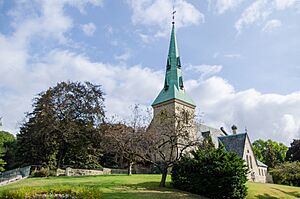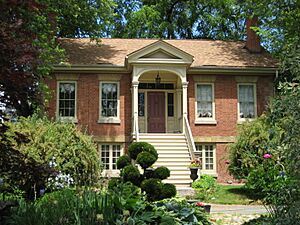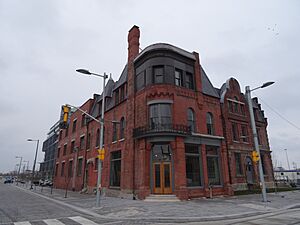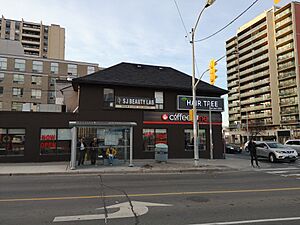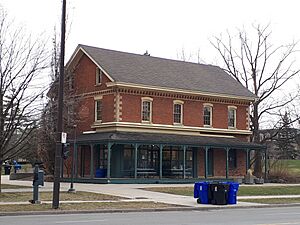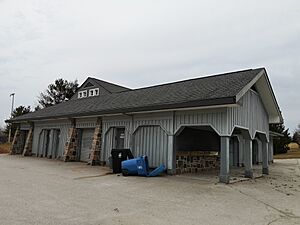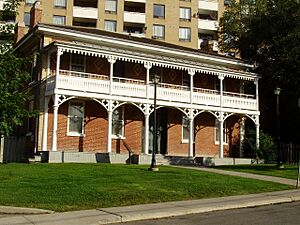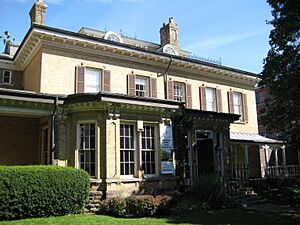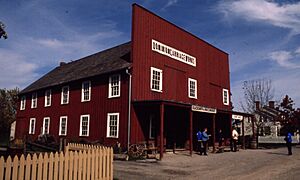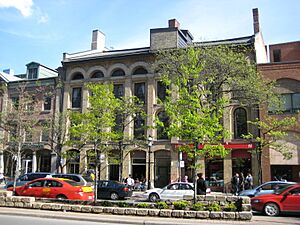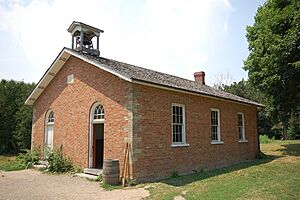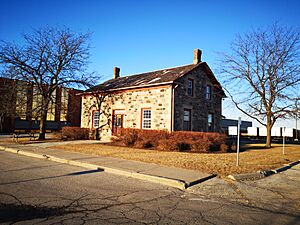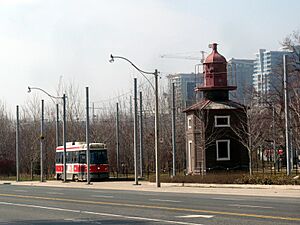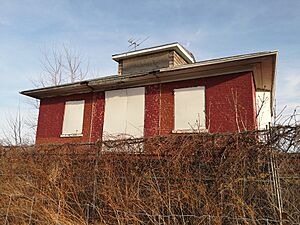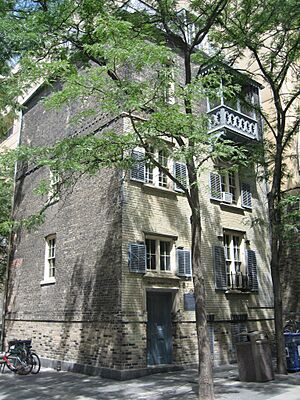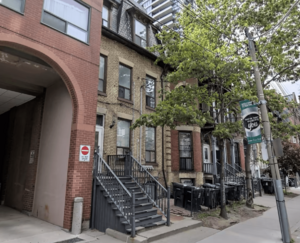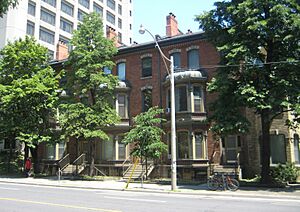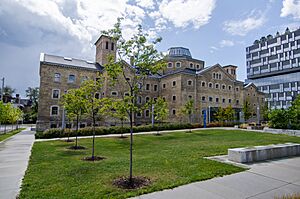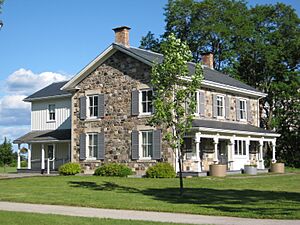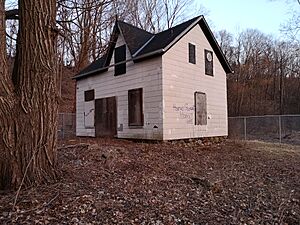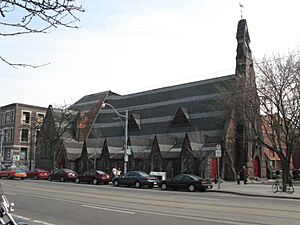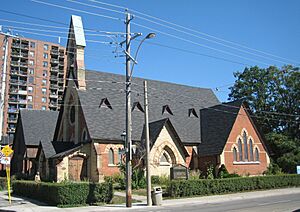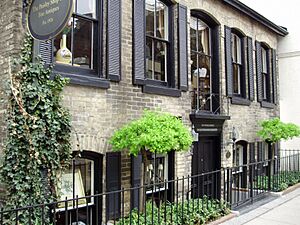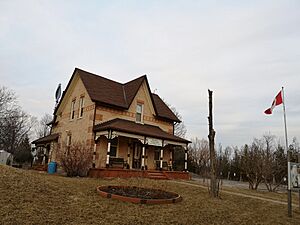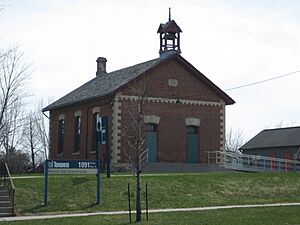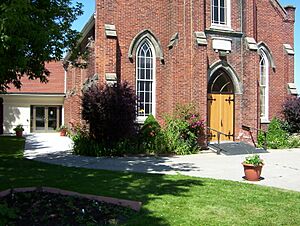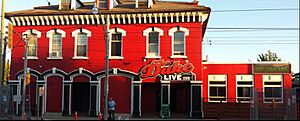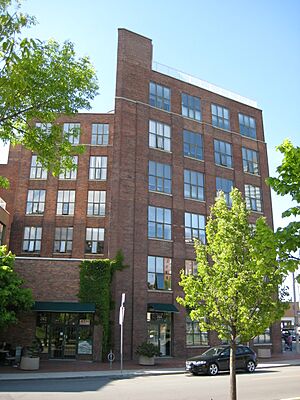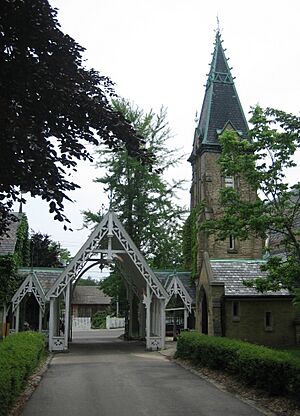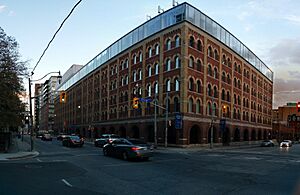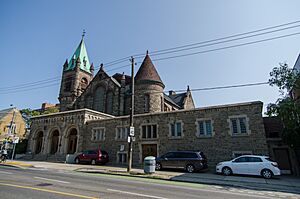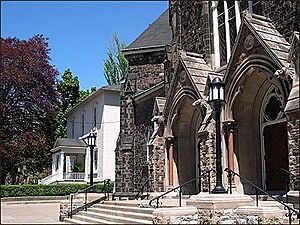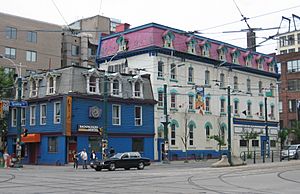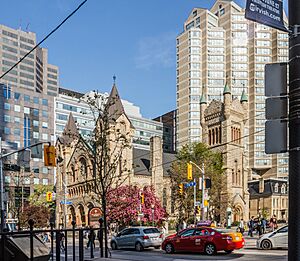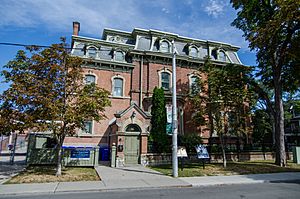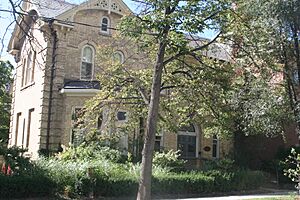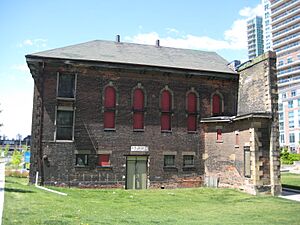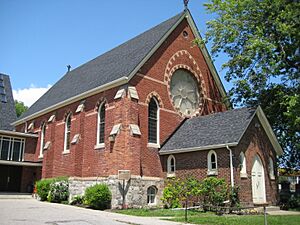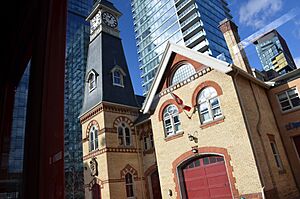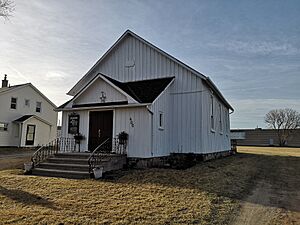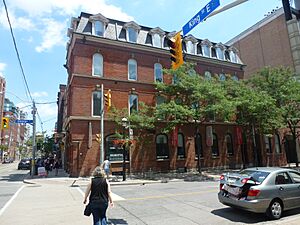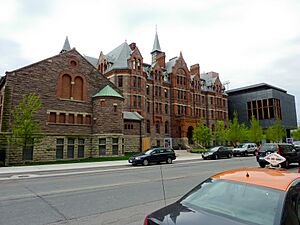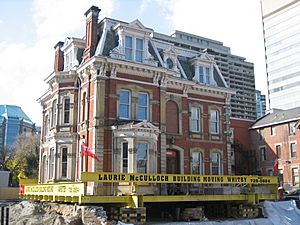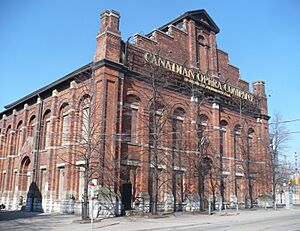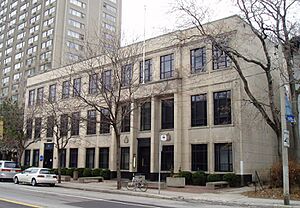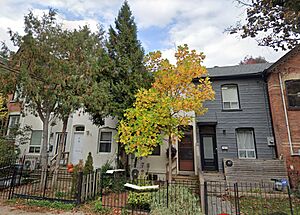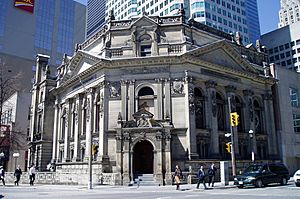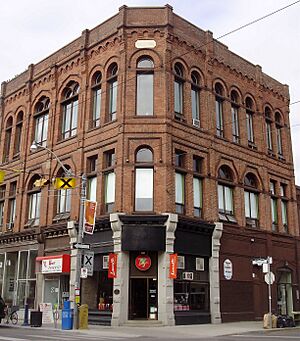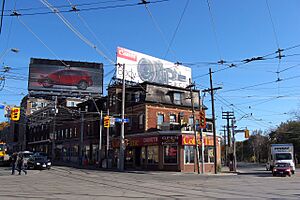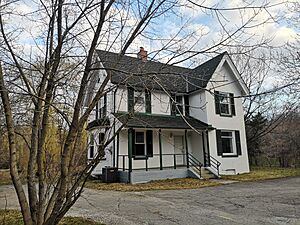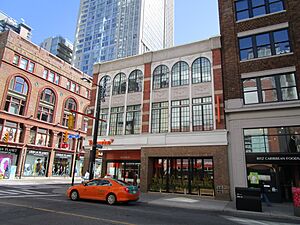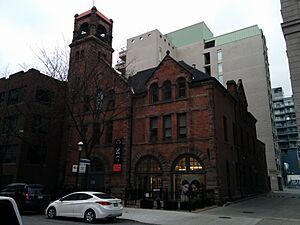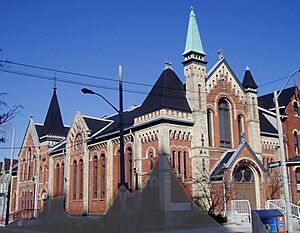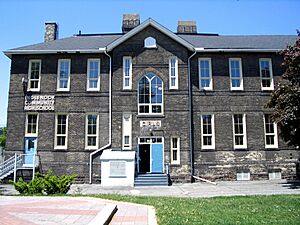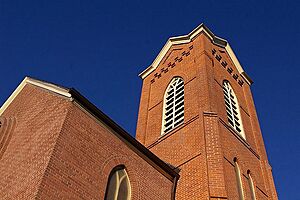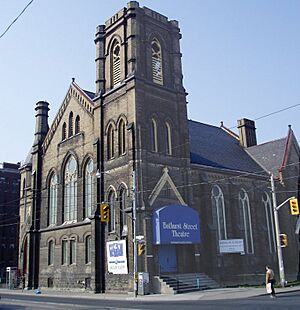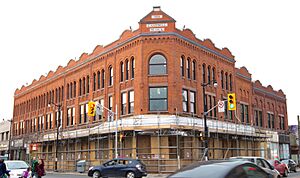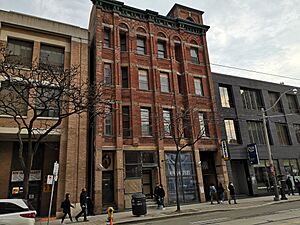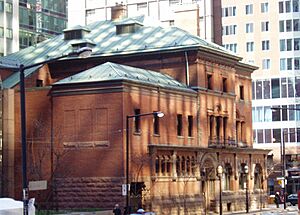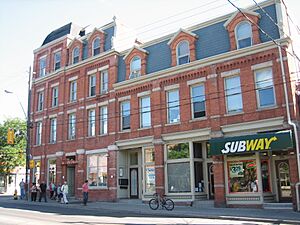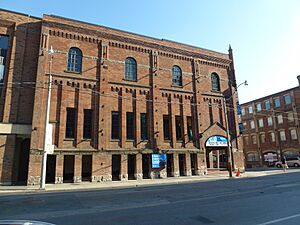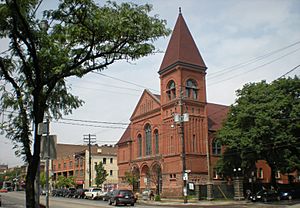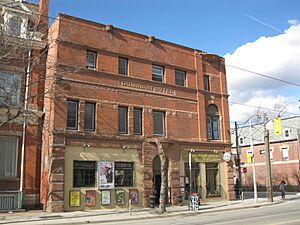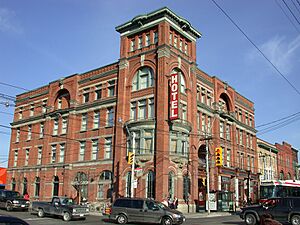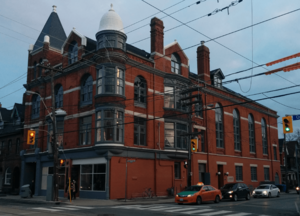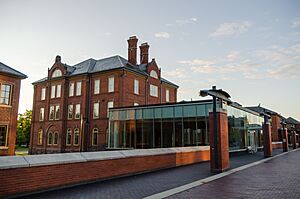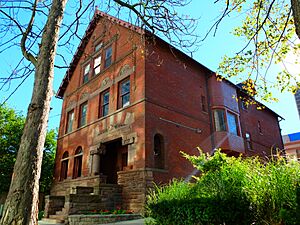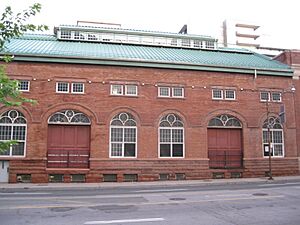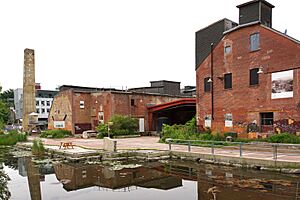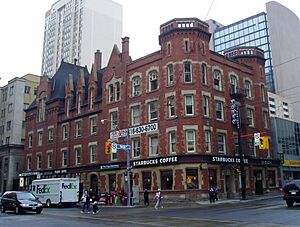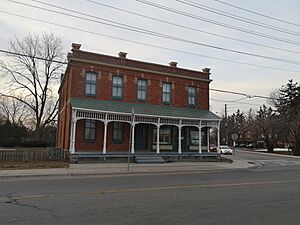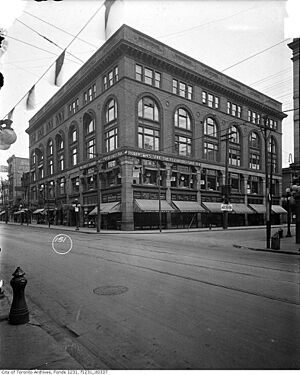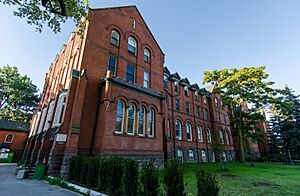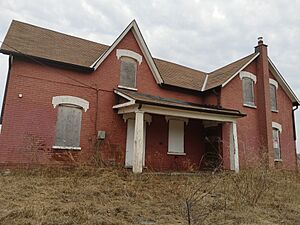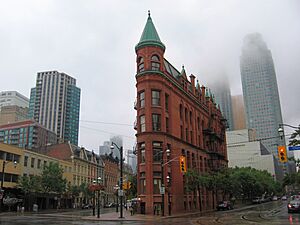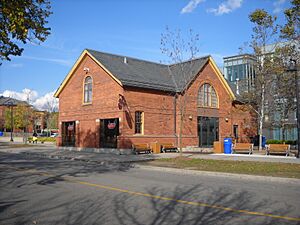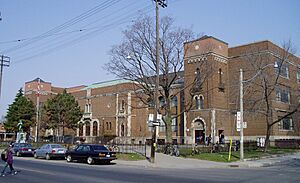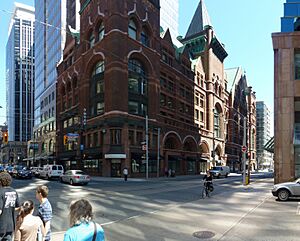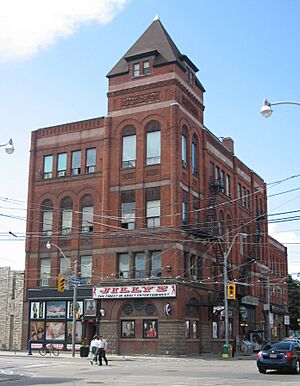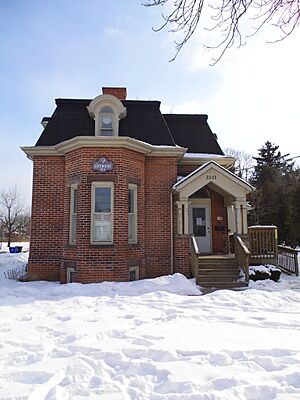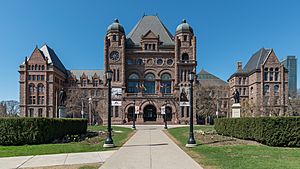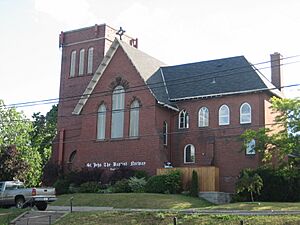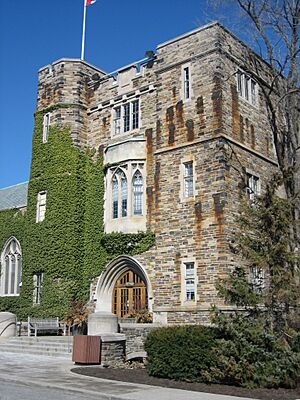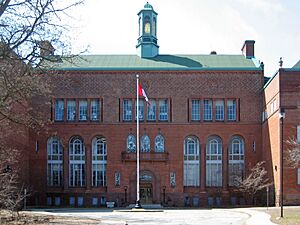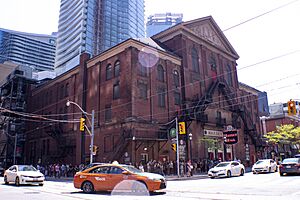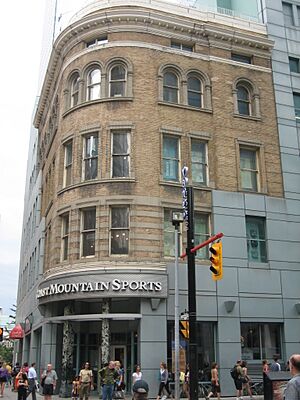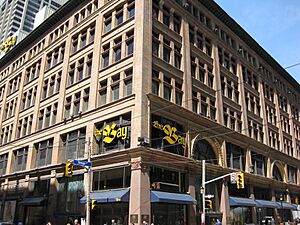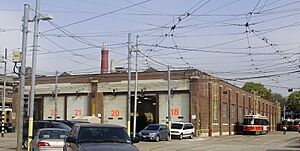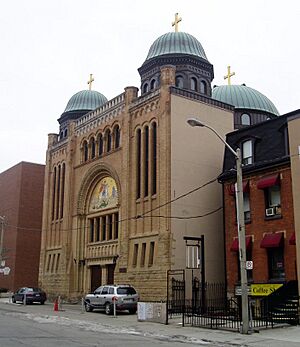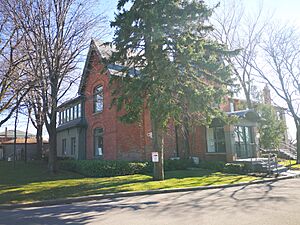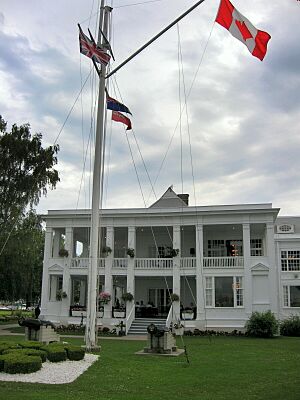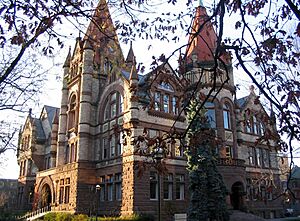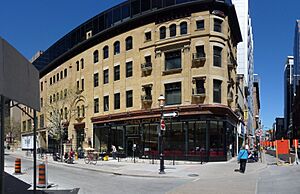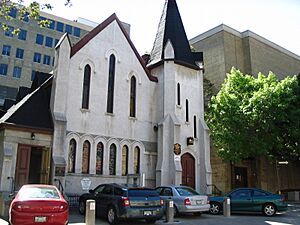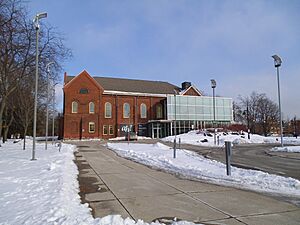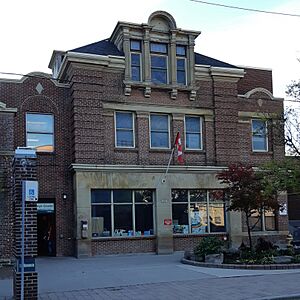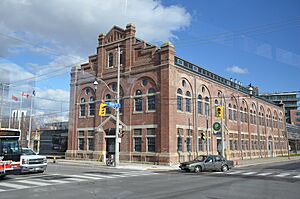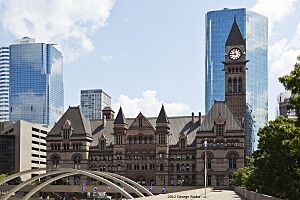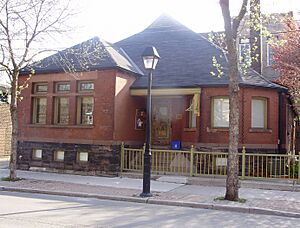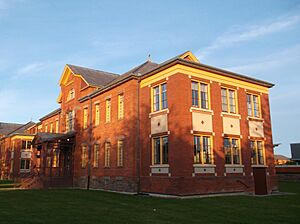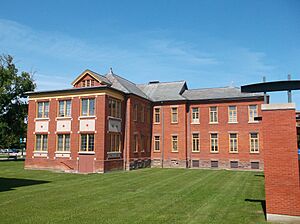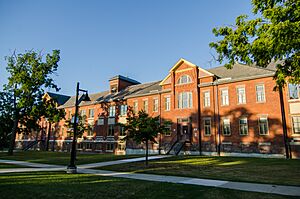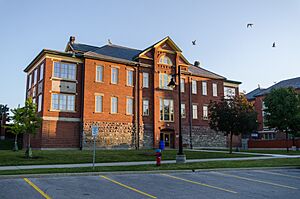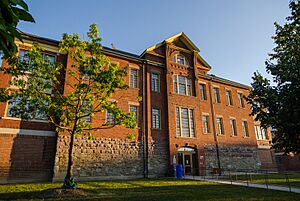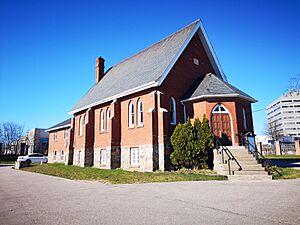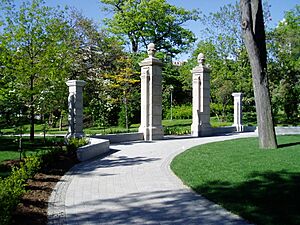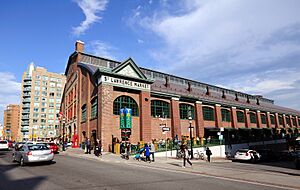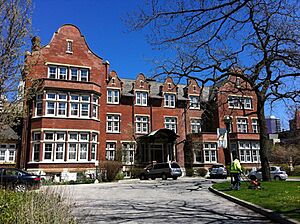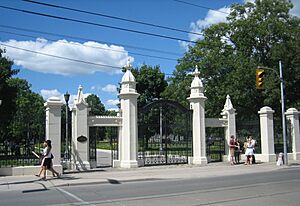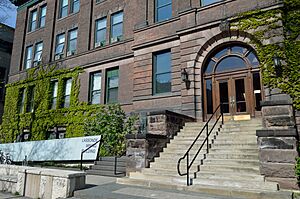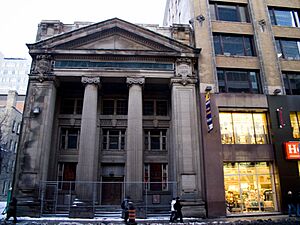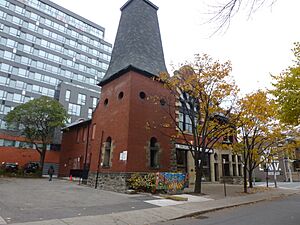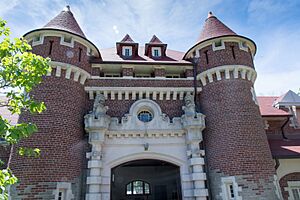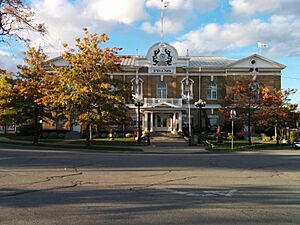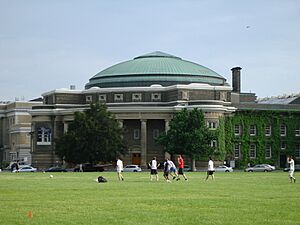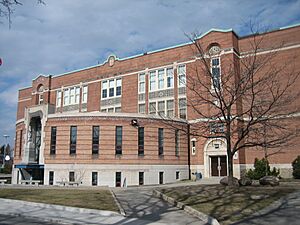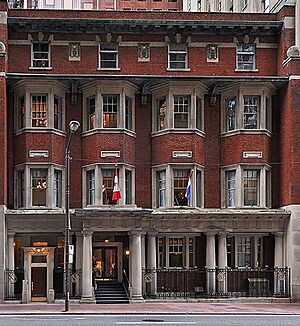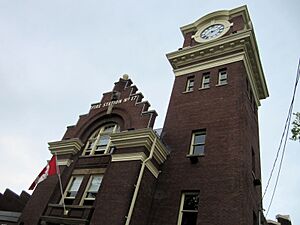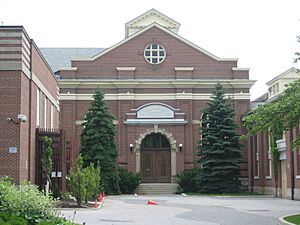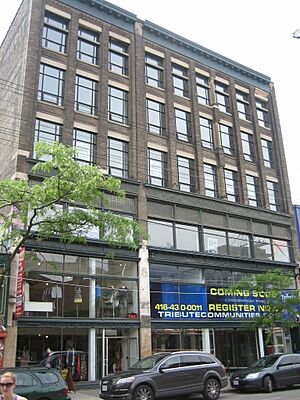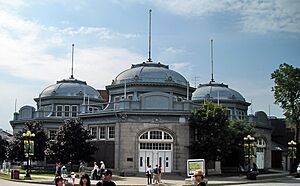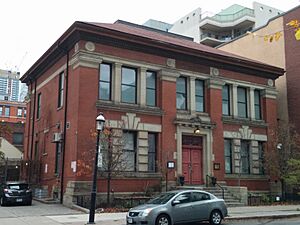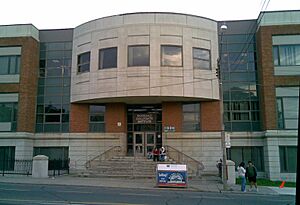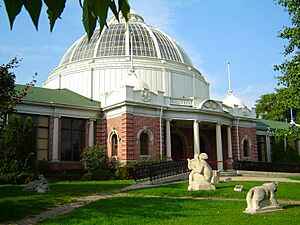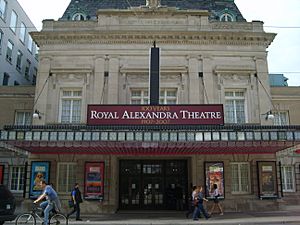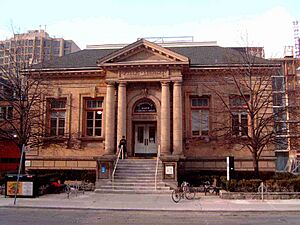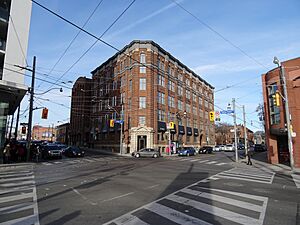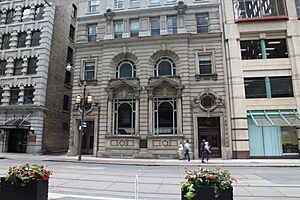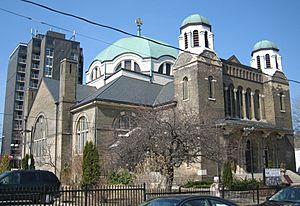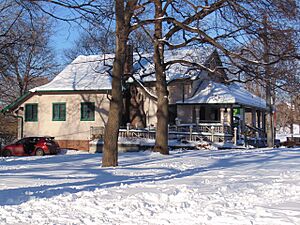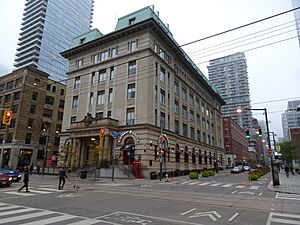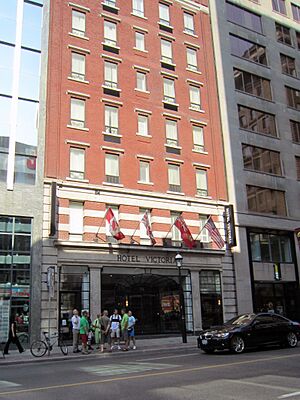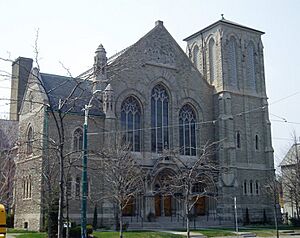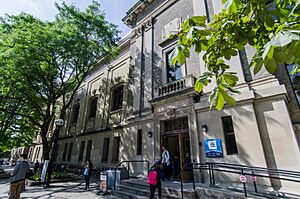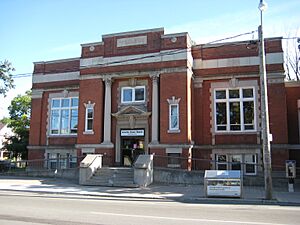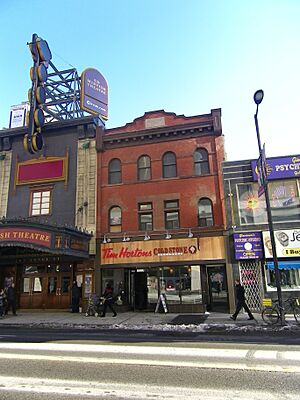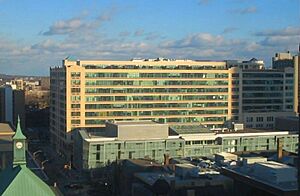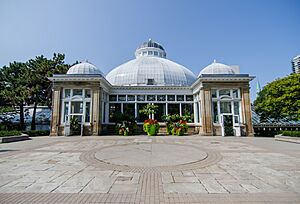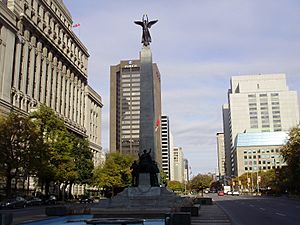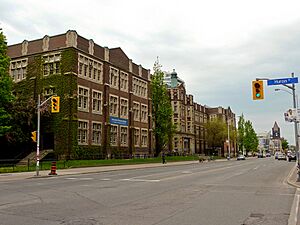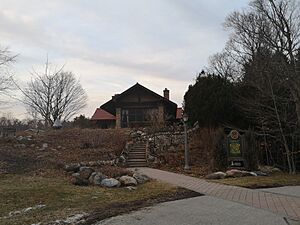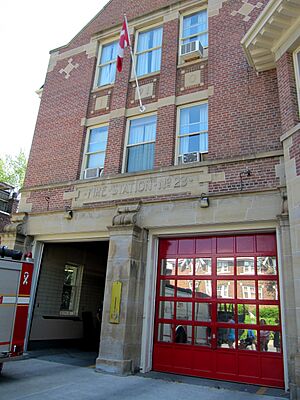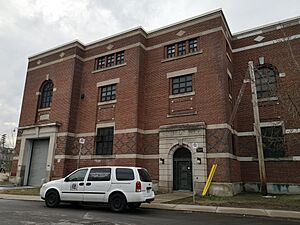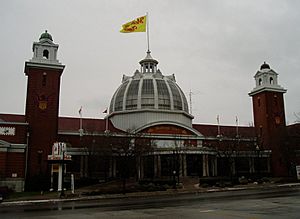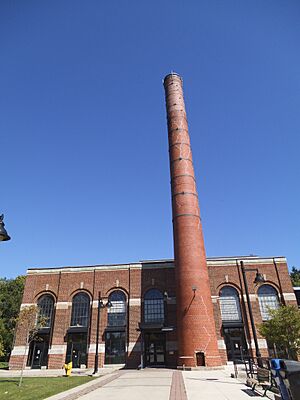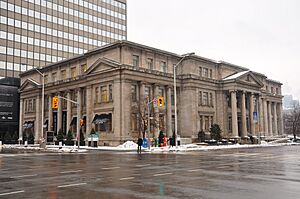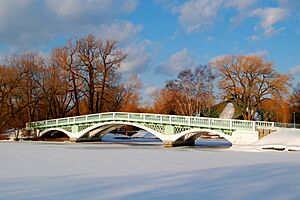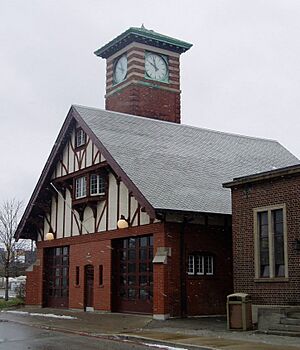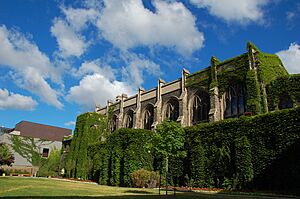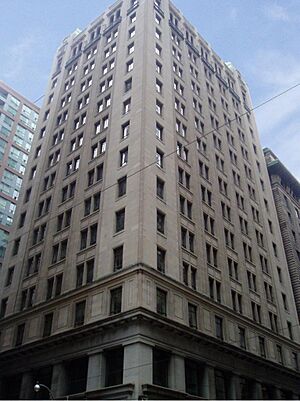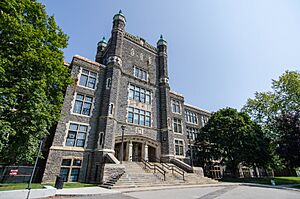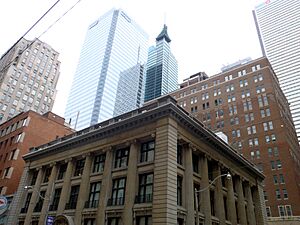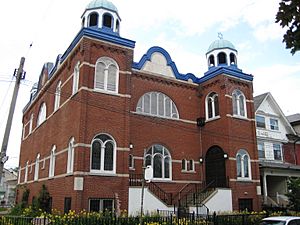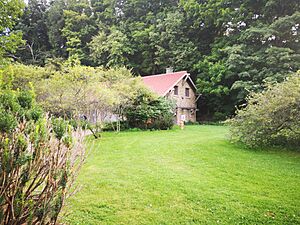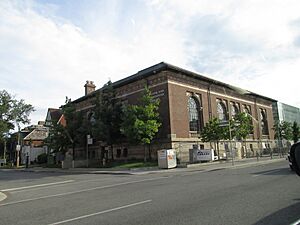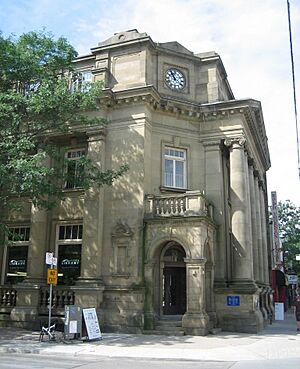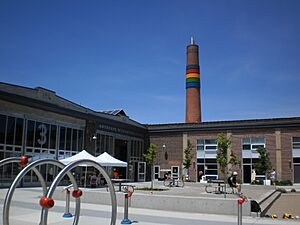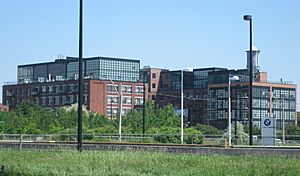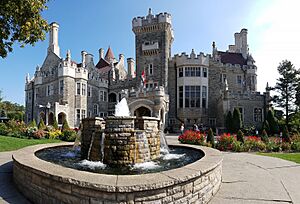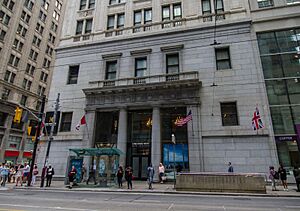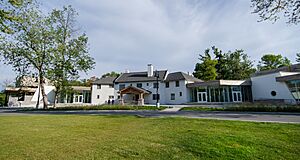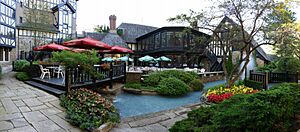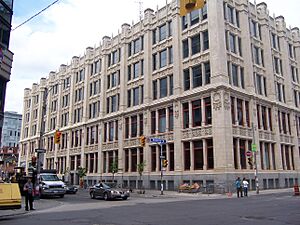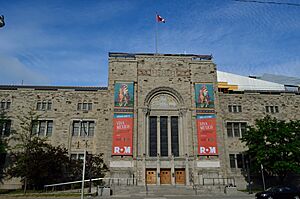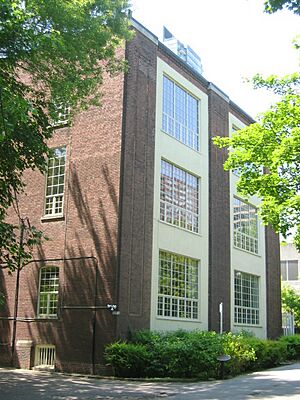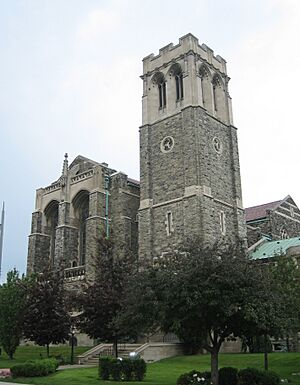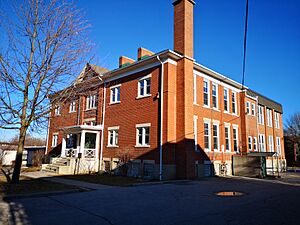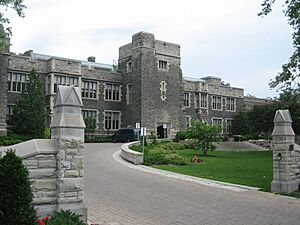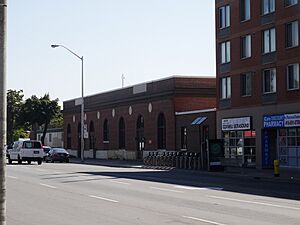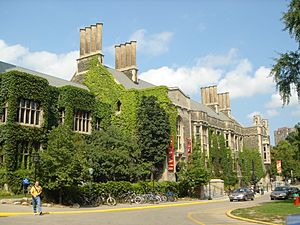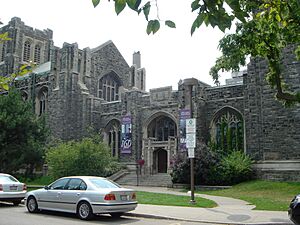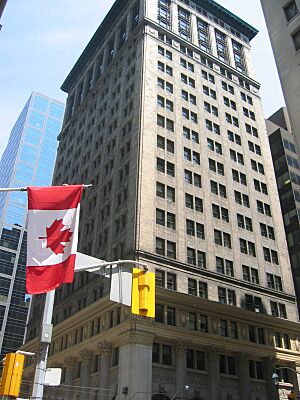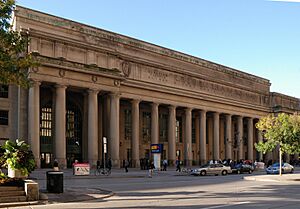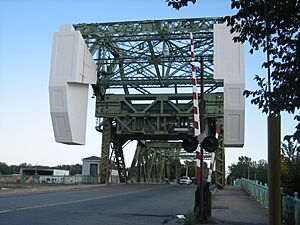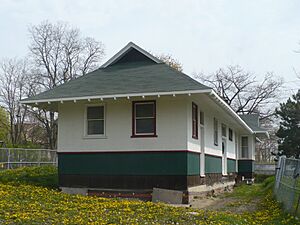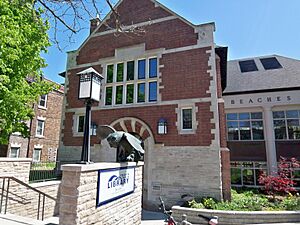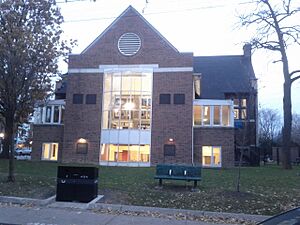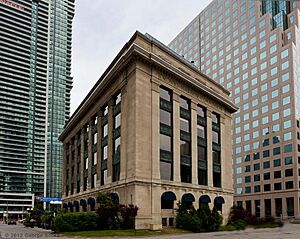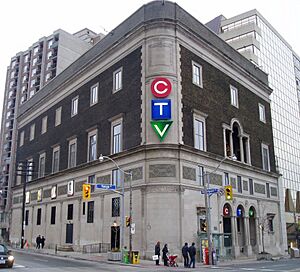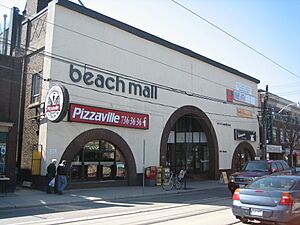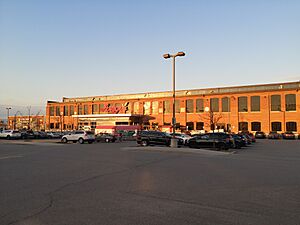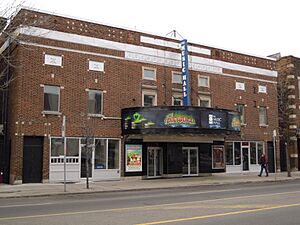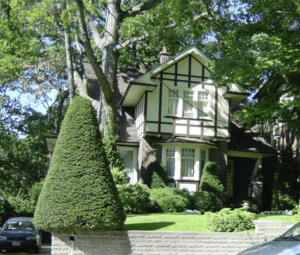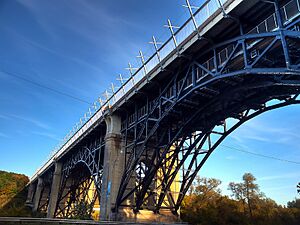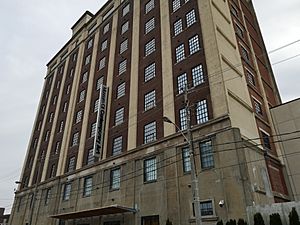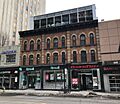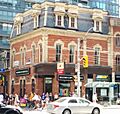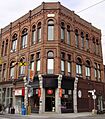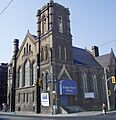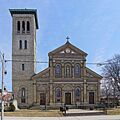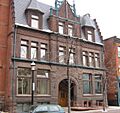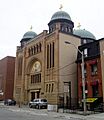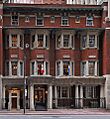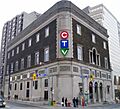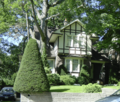List of oldest buildings and structures in Toronto facts for kids
Toronto has a long and exciting past, going back about 12,000 years to when Indigenous people lived here. But the oldest buildings you can still see today were built by European settlers. You can even find traces of an old Seneca village at the Bead Hill archaeological site in eastern Toronto.
The very first European building in Toronto was a French trading post called Magasin Royal, built in 1720. Later, in the 1750s, the French built more structures, like Fort Rouillé. But they destroyed them in 1759 after losing a battle.
In 1793, the government bought the land from the Mississaugas people. This was so British American colonists, called Loyalists, who had to leave the United States after the Revolutionary War, could settle here. Many of Toronto's oldest buildings come from this early British settlement time, when the town was known as York. York officially became the City of Toronto in 1834.
This list highlights some of Toronto's oldest and most interesting buildings that are still standing. These buildings are often protected because of their history. There are many other old houses and businesses built before 1920 in areas like Cabbagetown or Parkdale, but this list focuses on the most famous or unique ones.
Oldest Buildings Still Standing
The very oldest piece of European settlement might be a railing from St Paul's Cathedral in London, dating back to 1714. It's now part of John Howard's tomb in High Park. He had it shipped over in 1875!
This list doesn't include buildings where only the front wall (facade) has been kept, and the rest was rebuilt.
Buildings from 1794 to 1819
Many of these early buildings were homes or military structures. Some were even moved from their original spots years later!
- Scadding Cabin (1794): This is one of the oldest surviving buildings from the early days of Toronto. It's a simple log cabin built by John Scadding. Today, you can find it at Exhibition Place.
- Gibraltar Point Lighthouse (1809): This historic lighthouse stands on the Toronto Islands. It's one of the oldest lighthouses in Canada and has a famous ghost story!
- Fort York Blockhouses (1813): These strong, defensive buildings were part of Fort York, an important military site. They were built by the Royal Engineers to protect the town.
- Fort York Brick Barracks (1815): Also at Fort York, these brick buildings were where soldiers lived. They show what military life was like back then.
- Daniel Stong Loghouse (1816): This log house was built by Daniel and Elizabeth Stong. It's now part of Black Creek Pioneer Village, a place where you can see what life was like in the 1800s.
- The Grange (1817): This beautiful Georgian style house was built by D'Arcy Boulton. It's now connected to the Art Gallery of Ontario.
Buildings from 1820 to 1839
This period saw more permanent structures as Toronto grew.
- Campbell House (1822): This elegant Georgian home belonged to William Campbell, a chief justice. It was moved to its current spot on Queen Street West.
- Edgeley Mennonite Meeting House (1824): This building shows the simple style of Mennonite architecture. It's also at Black Creek Pioneer Village.
- Bank of Upper Canada Building (1827): This was an important bank building, designed by William Warren Baldwin. It has a Neoclassical style.
- Tollkeepers' Cottage Museum (1827–1830): This small cottage was where people paid tolls to use the roads. It gives a glimpse into early transportation.
- Montgomery's Inn (c. 1830): This old inn was a popular stop for travelers. It's a great example of Georgian style.
- Mackenzie House (c. 1830): This house is also at Black Creek Pioneer Village. It's a simple home that shows how people lived in the early 1800s.
- Osgoode Hall (1832): This grand building is home to courts and legal organizations. It features impressive Neoclassical and Palladian styles.
- Fourth York Post Office (1833): This was the main post office for the town of York. It's a good example of Georgian style.
- Daniel Brooke Building (1833): This building on King Street East also shows the Georgian style.
- McCowan's Log Cabin (1833): Another log cabin, this one is located in Thomson Memorial Park in Scarborough.
- Colborne Lodge (1836): This beautiful Regency Cottage was the home of John George Howard, who designed many early Toronto buildings and donated High Park to the city.
- The Black Bull (1838): This historic pub on Queen Street West has been around for a very long time!
Buildings from 1840 to 1849
More buildings appeared as Toronto grew, including important military and commercial structures.
- 98 Front Street East (1840): This building is a good example of early commercial architecture in the city.
- Stanley Barracks Officers' Quarters (1841): These quarters were part of the new fort built after the War of 1812.
- 105–109 King Street East (1842): These buildings were designed by William Thomas in the Georgian Revival style.
- Albany Club (1842): Originally known as Victoria Row, this building was also designed by John George Howard.
- Paul Bishop's House (1842): This house on Adelaide Street East is another example of early Toronto homes.
- Roblin's Mill (1842): This mill is now located at Black Creek Pioneer Village, showing how grain was processed long ago.
- Etobicoke Township Hall (1843): This building served as the local government office for Etobicoke. It's in the Georgian Revival style.
- Little Trinity Anglican Church (1843): This church is a beautiful example of Gothic Revival style.
- St. John's Anglican Church (1844): Another church in the Gothic Revival style, located in North York.
- St. George's on-the-Hill Anglican Church (1844): This church is an important part of Etobicoke's history.
- Ashbridge Estate (1854): This estate includes buildings from different periods, showing how families lived and worked over time.
- Osterhout Log Cabin (c. 1845): This log cabin is located in Guild Park and Gardens in Scarborough.
- Bishop's Palace of St. Michael's Cathedral (1846): This building, in the Gothic Revival style, is next to the cathedral.
- Church of the Holy Trinity (1847): This church, designed by Henry Bowyer Lane, is a significant example of Gothic Revival architecture.
- William Noble's Tavern (1847): This old tavern on King Street East shows the Second Empire style.
- Church of St. Jude (1848): This church in Scarborough is known for its Carpenter Gothic style.
- Enoch Turner School (1848): This was one of Toronto's first free schools for children. It's a very important historical site.
- Oakham House (1848): This building, designed by William Thomas, is in the Gothic Revival style.
- St. Michael's Cathedral Basilica (1848): This grand cathedral is a stunning example of English Gothic style.
- Toronto House of Industry (1848): This building was a shelter for the poor and homeless. It was also designed by William Thomas.
- Half Way House Inn (1849): This inn is now at Black Creek Pioneer Village. It was a stopping point for travelers.
- The Wheat Sheaf (1849): This pub on King Street West is one of Toronto's oldest.
Buildings from 1850 to 1859
This decade saw more growth and the construction of important public buildings.
- Charles Irvine Weaver Shop (1850): This shop, now at Black Creek Pioneer Village, shows how weaving was done in the past.
- St. Lawrence Hall (1850): This beautiful building, designed by William Thomas, is in the Renaissance Revival style. It was an important public meeting place.
- Taylor's Cooperage (c. 1850): This building, also at Black Creek Pioneer Village, was where barrels were made.
- Tinsmith Shop and Masonic Lodge (c. 1850): This building, with its Gablefront style, is another part of Black Creek Pioneer Village.
- Gibson House (1851): This house belonged to David Gibson. It's now a museum in Willowdale.
- Melville Church (1851): This church is located in West Hill, Scarborough.
- Adelaide Street Court House (1852): This courthouse was designed by Frederick William Cumberland and Thomas Ridout in the Greek Revival style.
- Consumers' Gas Building (1852): This building was for the Consumers' Gas Company and is in the Renaissance Revival style.
- Jacob P. Ross House (1852): This house is located in Glen Park, North York.
- Alexander Muirhead Farm House (1853): This old farm house is in Pleasant View, North York.
- Toronto Street Post Office (1853): This post office is another example of Greek Revival style.
- Paul Kane House (1854): This was the home of famous painter Paul Kane.
- Thomas Clark House (1854): This house is in the Upright and Wing style.
- 399–403 King Street East (1854): These buildings are part of the historic Corktown area.
- Hutchison Building (1854): This building is on Wellington Street East.
- O'Keefe House (1854): This house is located in the Garden District.
- Emporium and Post Office (1855): This building, now at Black Creek Pioneer Village, served as a general store and post office.
- Harness Shop and Saddlery (1855): Another building at Black Creek Pioneer Village, where leather goods were made.
- Allandale (1856): This historic house in Cabbagetown was built by Enoch Turner.
- Fisherville Church (1856): This church is also at Black Creek Pioneer Village.
- William Wall House (1856): This house is on Seaton Street in Cabbagetown.
- Auberge du Pommier Restaurant (1856): Originally Hogg's Hollow Cottage, this building is now a restaurant.
- Northfield Estate (1856): This estate is now part of Canada's National Ballet School.
- St. Basil's Church (1856): This church was designed by William Hay.
- University of St. Michael's College (1856): This is one of the colleges at the University of Toronto.
- Rose Blacksmith Shop (c. 1856): This shop, at Black Creek Pioneer Village, shows how blacksmiths worked.
- Davis House (1857): Also known as Geary House, this building is in Rosedale.
- William Devenish House (1857): This house is located in Clairlea, Scarborough.
- Mackenzie House (1857): This house was the last home of William Lyon Mackenzie, Toronto's first mayor. It's now a museum.
- Miller Tavern (1857): This historic tavern is in York Mills, North York.
- Toronto Magnetic and Meteorological Observatory (1857): This observatory was important for studying weather and the Earth's magnetic field.
- Tin and Copper Smith Building (1857): This building was designed by Joseph Sheard.
- Cornell House (1858): This house is in the Upright and Wing style and is located in Thomson Memorial Park in Scarborough.
- Flynn House (1858): This house is another building at Black Creek Pioneer Village.
- Green House (1858): This building on Gerrard Street East is in the Georgian Revival style.
- Thomas Helliwell Block (1858): This building on Front Street East is in the Georgian Revival style.
- Edward Leadlay Company (1858): This warehouse on Front Street East is in the Georgian Revival style.
- St. James The Less Chapel (1858): This chapel, designed by Frederick William Cumberland and William George Storm, is in the Gothic Revival style.
- Wilmot Township Hall (1858): This building, now at Black Creek Pioneer Village, was a township hall.
- Daniel Flynn Boot and Shoe Shop (c. 1858): This shop, also at Black Creek Pioneer Village, shows how shoes were made.
- Bain House (1859): This house is located in Riverdale.
- Cherry Street Hotel (1859): This historic hotel was designed by Joseph Sheard.
- University College Main Building (1859): This iconic building at the University of Toronto features Norman and Romanesque Revival styles.
- University College Croft House (1859): Also part of University College, this building was designed by Frederick William Cumberland.
- Newtonbrook Store (c. 1850s): This old store is in Newtonbrook, North York.
Buildings from 1860 to 1869
This decade saw more churches and commercial buildings, reflecting Toronto's growth.
- St. Paul's, Bloor Street (1860): This church is located on Bloor Street East.
- Dempsey Store (1860): This store is in Willowdale, North York.
- Garibaldi House (1860): This house is on King Street East.
- Neilson Park Fieldhouse (1860): This fieldhouse is in Neilson Park, Scarborough.
- Oaklands (1860): This building, now part of De La Salle College, is in the Gothic Revival style.
- John Richardson House (1860): This house is in West Hill, Scarborough.
- Lambton House (1860): This historic house is in Lambton, York.
- Cumberland House (1860): This house is on St. George Street.
- Dominion Carriage Works and Cabinet Shop (c. 1860): This shop, at Black Creek Pioneer Village, shows how carriages and furniture were made.
- Alexander Smith Block (1861): This building is on Front Street East.
- Dickson Hill School (1861): This old schoolhouse is at Black Creek Pioneer Village.
- Gooderham and Worts Distillery Stone Distillery (1861): This large stone building is a key part of the historic Distillery District. It's a great example of Victorian industrial design.
- James Weir House (1861): This house is in Armadale, Scarborough.
- Queen's Wharf Lighthouse (1861): This lighthouse is an important part of Toronto's port history.
- William Stonehouse House (1861): This house is also in Armadale, Scarborough.
- Henry Scadding Home (1862): This house belonged to Henry Scadding, a historian.
- Alfred Walton Stores (1862): These stores are on Yonge Street.
- Frederick Bell-Smith House (1863): This house is on Jarvis Street.
- Snarr's Terrace (1863): This row of houses on Jarvis Street was built by Thomas Snarr.
- Don Jail (1864): This former jail is a striking example of Italianate style. It's now part of a hospital.
- Elderslie (1864): This building is in Malvern, Scarborough.
- Gooderham & Worts Distillery Brick Malthouse (1864): Another building in the Distillery District.
- John Wanless Building (1864): This building is on Yonge Street.
- John McBean Building (1864): Also on Yonge Street.
- David Duncan House (1865): This house is in Graydon Hall, North York.
- Milne House (1865): This house, built by Alexander Milne, is in Victoria Village, North York.
- St. Stephen-in-the-Fields Anglican Church (1865): This church was designed by Henry Langley.
- St. Peter's Anglican Church (1866): This church in Cabbagetown was designed by Grundy and Henry Langley.
- Spadina House (1866): This historic mansion was the home of James Austin. It's now a museum where you can learn about Toronto's past.
- John Daniels House (1867): This house is in Yorkville.
- W. Davies and Company Pork Packing (1867): This building was a pork packing plant, later used by J. & J. Taylor Safeworks.
- Keg Mansion (1868): Originally Euclid Hall, this building is now a popular restaurant.
- Edward Leadlay Co. Warehouse (1858): This warehouse on Front Street East is in the Georgian Revival style.
- St. James The Less Chapel (1858): This chapel, designed by Frederick William Cumberland and William George Storm, is in the Gothic Revival style.
- Richard West Houses (1869): These houses on John Street were built by Richard West.
- Rouge Valley Conservation Centre (1869): This centre is in Rouge, Scarborough.
- Zion Schoolhouse (1869): This old schoolhouse is in Don Valley Village, North York.
Buildings from 1870 to 1879
This period saw the construction of many more homes, churches, and commercial buildings as Toronto continued to expand.
- Downsview United Church (1870): This church is in Downsview, North York.
- Duke of York Inn (1870): This historic inn is in Leslieville.
- Rueter House (1870): This house is in Newtonbrook, North York.
- 55–79 Berkeley Street (1871): These are historic workers' cottages.
- Berkeley Castle (1871): This building on Berkeley Street was built by Joseph Simpson.
- Metropolitan United Church (1872): This large church is a stunning example of French Gothic style.
- Toronto Fire Department Fire Hall #3 (tower) (1872): This fire hall tower is on Yonge Street.
- Toronto Necropolis Chapel (1872): This chapel is located in the historic Toronto Necropolis cemetery.
- Cathedral Church of St. James (1874): This grand cathedral is a major landmark in Toronto, built in the Gothic Revival style.
- Christie, Brown & Company Factory (1874): This factory is now part of George Brown College.
- Sait Luke's United Church (1874): This church was designed by Henry Langley and Edmund Burke.
- 1 Spadina Crescent (1875): This unique building is part of the University of Toronto.
- Jarvis Street Baptist Church (1875): This church is on Gerrard Street East.
- Richardson House (later the Spadina Hotel) (1875): This building on King Street West later became the Spadina Hotel.
- St. Andrew's Church (1875): This church was designed by William George Storm.
- George Brown House (1876): This house, in the Second Empire style, belonged to George Brown, a Father of Confederation.
- Brunswick House (1876): This building on Bloor Street West is a historic landmark.
- Olivet Congregational Church (presently Heliconian Hall) (1876): This building is now home to the Heliconian Club.
- Don Brewery T. Davies & Bro Malt House (1877): This building was part of the Don Brewery.
- Mary Perram House (1877): This house is on Wellesley Place.
- Toronto Central Prison Chapel (1877): This chapel was part of the Toronto Central Prison.
- Zion Wexford Church (1877): This church is in Wexford, Scarborough.
- Toronto Fire Services Station 315 (1878): This old fire station is in Kensington Market.
- Grace Toronto Church (1878): This church, designed by Henry Langley & Edmund Burke, is in the Gothic Revival style.
- Toronto Fire Services Station 312 (1878): This former fire station in Yorkville is in the Victorian Gothic style.
- Church of the Redeemer (1879): This church is on Bloor Street West.
- William Copeland Buildings (1879): These buildings are on King Street East.
- St.Stanislaus Kostka Church (1879): Originally the West Presbyterian Church, this building is now St. Stanislaus Kostka Church.
Buildings from 1880 to 1889
This decade saw the construction of more commercial buildings, hotels, and important institutions.
- Armadale Free Methodist Church (1880): This church in Armadale, Scarborough, was built by volunteer labourers.
- Little York Inn (1880): This inn on King Street East is in the Second Empire style.
- Little York Inn stables (1880): These stables are next to the Little York Inn.
- William Barber Building (1880): This building is on King Street West.
- McMaster Hall (1881): This building, part of the Royal Conservatory of Music, was designed by Henry Langley & Edmund Burke.
- James Cooper House (1881): This house in St. James Town is in the Second Empire style.
- Standard Woolen Mill (1882): This mill is now the Tannenbaum Opera Centre.
- Brockton Town Hall (1882): This building served as the town hall for Brockton.
- St. Andrew-by-the-Lake Church and Bishop's Cottage (1884): This church is located on the Toronto Islands.
- Toronto Metropolitan University Centre for Urban Innovation (1885): This building was originally the Ontario College of Pharmacy.
- Townhouses Sumach Street (1885): These townhouses are on Sumach Street.
- Hockey Hall of Fame (1885): This famous building was originally the Bank of Montreal. It's a great example of architecture by Frank Darling & S. George Curry.
- Poulton Block (1885): This building in Riverdale is in the Gothic Revival style.
- Scholes Hotel (later Ocean Hotel) (1885): This hotel in Parkdale is in the Second Empire style.
- St. Mary's Church (1885): This church was designed by Joseph Connolly.
- George S. Pratt House (1886): This house is in York Mills, North York.
- John E. Thompson Block (1886): This building is on Yonge Street.
- Lombard Street Fire Hall (1886): This historic fire hall is in Old Town.
- Toronto Chinese Baptist Church (1886): Originally Beverley Street Baptist Church, this church was designed by Henry Langley & Edmund Burke.
- Inglenook Community High School (1887): This school is in Corktown.
- Robert Armstrong House (1887): This house in the Garden District is in the Second Empire style.
- Chester D. Massey House (1887): This house, designed by E. J. Lennox, is in the Queen Anne Revival style.
- Central United Church (1887): This church is in Weston, York.
- Bathurst Street Theatre (1888): Originally Bathurst Street Methodist Church, this building is now a theatre.
- Campbell Block (1888): This building is in The Junction.
- Nealon House (1888): This building is on King Street East.
- The Toronto Club (1888): This club building was designed by Frank Darling & S. George Curry.
- Winchester Hotel (1888): Formerly the Lakeview Hotel, this building is in Cabbagetown.
- Young People's Theatre (1888): This theatre was originally the Toronto Street Railway stables.
- St. Paul's Basilica (1889): This basilica, designed by Joseph Connolly, is in the Romanesque Revival style.
- Bloor Street United Church (1889): This church is in The Annex.
- College Street Baptist Church (1889): This church is on College Street.
- Dominion Hotel (1889): This historic hotel is on Queen Street East.
- Fairbank United Church (1889): This church is in Glen Park, North York.
- Gladstone Hotel (1889): This hotel is in the Romanesque Revival style.
- The Great Hall (1889): This building, designed by Gordon & Helliwell, is in the Victorian style.
- Lakeshore Psychiatric Hospital Administration Building (1889): This building was designed by Kivas Tully.
- Rupert Simpson House (1889): This house on Wellesley Place is in the Richardsonian Romanesque style.
- Toronto Hydro Dynamo House (1889): This building was a power station for Toronto Hydro.
- Trinity-St. Paul's United Church (1889): This church was designed by Henry Langley & Edmund Burke.
Buildings from 1890 to 1899
The late 1800s brought more industrial and public buildings, showing Toronto's rapid growth.
- Don Valley Brick Works (1890): This historic industrial site produced bricks for many Toronto buildings. It's now a park and community hub.
- Drake Hotel (1890): This hotel on Queen Street West is a well-known landmark.
- G. H. Gooderham House (1890): This house, designed by David Roberts Jr., is in the Richardsonian Romanesque style.
- Rotman's Men's Shop (1890): This shop on Spadina Avenue was designed by William George Storm.
- Sunlight Soap/Lever Brothers Works Factory (1890): This factory was for making soap.
- Swansea Public School (1890): This school in Swansea is in the Romanesque Revival style.
- Athenaeum Club (1891): This building on Church Street features a unique Moorish Revival style.
- Independent Order of Odd Fellows Hall (1891): This hall was designed by Norman Dick & Frank Wickson.
- J. Morrish General Store (1891): This general store is in Highland Creek, Scarborough.
- Ryrie Building (1891): This building on Yonge Street is in the Palazzo style.
- St. George's Hall (now Arts and Letters Club) (1891): This building is now home to the Arts and Letters Club.
- Wycliffe College (1891): This college is part of the University of Toronto.
- Underwood House (1891): This house is in Armadale, Scarborough.
- George Gooderham House (now York Club) (1892): This grand house, designed by David Roberts Jr., is in the Romanesque Revival style. It's now the York Club.
- Gooderham Building (1892): Also known as the Flatiron Building, this iconic building was designed by David Roberts Jr. in the Romanesque Revival style.
- Lakeshore Psychiatric Hospital Carriage House (1892): This building was part of the Lakeshore Psychiatric Hospital complex.
- Victoria Hospital for Sick Children (1892): This hospital was designed by Frank Darling & S. George Curry in the Romanesque Revival style.
- Harbord Collegiate Institute (1892): This high school is in Palmerston–Little Italy.
- Confederation Life Building (1892): This building on Richmond Street East is in the Romanesque Revival style.
- Broadview Hotel (1893): Originally Dingman's Hall, this hotel in Riverdale is in the Romanesque Revival style.
- Lakeshore Psychiatric Hospital Gatehouse (1893): This gatehouse was designed by Kivas Tully.
- Ontario Legislative Building (1893): This is where the provincial government of Ontario meets. It's a grand building in the Richardsonian Romanesque style.
- St John the Baptist (Norway) Anglican Church (1893): This church is in the Upper Beaches.
- Havergal College (1894): This private girls' school is in Lytton Park.
- Humberside Collegiate Institute (1894): This high school is in High Park North.
- Massey Hall (1894): This famous concert hall has a Palladian exterior and a Moorish Revival interior.
- F. W. Woolworth Building (1895): This building on Yonge Street was once a Woolworth's department store.
- Robert Simpson Co. (now Hudson's Bay Queen Street) (1895): This large department store building is now a Hudson's Bay store.
- Roncesvalles Carhouse (1895): This building is a streetcar maintenance facility.
- St. George's Greek Orthodox Church (1895): This church was originally the Holy Blossom Temple.
- Don CPR railway station (1896): This old train station is now part of Roundhouse Park.
- George Jackson House (1896): This house is in Downsview, North York.
- Royal Canadian Yacht Club (1896): This club building on the Toronto Islands was designed by Dick & Wickson.
- Scarboro Centennial Memorial Library (1896): This library is in Bendale, Scarborough.
- Victoria University (1896): This university building is part of the University of Toronto.
- Dineen Building (1897): This building is in the Financial District.
- First Evangelical Lutheran Church (1898): This church on Bond Street is in the Gothic Revival style.
- Lakeshore Psychiatric Hospital Assembly Hall (1898): This hall was part of the Lakeshore Psychiatric Hospital complex.
- Masaryk-Cowan Community Recreation Centre (1898): This centre in Parkdale was designed by Frank Darling and John Pearson.
- Toronto Police Service 51 Division (1898): This police station was formerly the Consumer's Gas Co. Station A.
- Don Station (1899): This preserved train station is also in Roundhouse Park.
- Old City Hall (1899): This iconic building, designed by E. J. Lennox, is a grand example of Romanesque Revival architecture. It served as Toronto's city hall for many years.
- Parkdale Telephone Exchange Building (1899): This building is in Parkdale.
Buildings from 1900 to 1909
The early 1900s saw more modern architectural styles emerge, alongside continued growth in public services.
- Lakeshore Psychiatric Hospital Buildings C, D, E, F, H, I, J, K (1900): These buildings were part of the large Lakeshore Psychiatric Hospital complex, designed by Kivas Tully.
- Wymilwood (now Falconer Hall) (1901): This building, designed by Sproatt & Rolph, is now part of the University of Toronto's Faculty of Law.
- Holwood House (now Flavelle House) (1901): Also part of the Faculty of Law, this building is in the Georgian Revival style.
- Free Reformed Church of Toronto (1901): This church is in York University Heights, North York.
- Gates of Philosopher's Walk (1901): These gates lead to a scenic path at the University of Toronto.
- Bank of Hamilton (1902): This bank building on Spadina Avenue was designed by G. W. Gouinlock.
- St. Lawrence Market South (1902): This market building is a popular spot for food and goods.
- Annesley Hall (1903): This building at Victoria University is in the Queen Anne Revival style.
- Kimberley Junior Public School (1903): This school is in the Upper Beaches.
- King Edward Hotel (1903): This grand hotel on King Street East was designed by E. J. Lennox.
- Trinity College Gates (1903): These gates lead into Trinity Bellwoods Park.
- Lassonde Mining Building (1904): This building at the University of Toronto was designed by Francis R. Heakes.
- 197 Yonge Street (1905): This building is on Yonge Street.
- Alumnae Theatre (1905): This theatre is on Berkeley Street.
- Casa Loma Stables (1905): These stables are part of the famous Casa Loma estate.
- CNE Press Building (1905): This building is at Exhibition Place.
- Trader's Bank Building (1905): This building on Yonge Street was designed by Carrère and Hastings.
- Crescent School (1906): This school was originally the home of Frank Porter Wood.
- Convocation Hall (1906): This large hall at the University of Toronto was designed by Darling and Pearson.
- Malvern Collegiate Institute (1906): This high school is in the Upper Beaches.
- National Club (1906): This club building is in the Georgian Revival style.
- Toronto Fire Services Station 227 (1906): This fire station in The Beaches is in the Amsterdam School style.
- Toronto Water High Level Pumping Station (1906): This pumping station helps provide water to the city.
- 205 Yonge Street (1906): This building, designed by E. J. Lennox, is in the Neoclassical style.
- Antique Carousel (1907): This carousel is at Centreville Amusement Park on the Toronto Islands.
- Bank of Commerce (1907): This bank building on King Street East is in the Neoclassical style.
- Burroughes Building (1907): This building on Queen Street West is a historic commercial building.
- CNE Music Building (1907): This building at Exhibition Place is in the Beaux-Arts style.
- Fred Victor Centre Women's Hostel (1907): This building was formerly the City Morgue.
- Riverdale Collegiate Institute (1907): This high school is in Leslieville.
- Horticulture Building (1907): This building at Exhibition Place is used for horticultural displays.
- Royal Alexandra Theatre (1907): This beautiful theatre, designed by John M. Lyle, is in the Beaux-Arts style.
- Toronto Public Library Yorkville branch (1907): This library branch is in Yorkville.
- Aluminum & Crown Stopper Company (1908): This building on King Street East was designed by Frederick H. Herbert & Henry Simpson.
- Birkbeck Building (1908): This building on Adelaide Street East was designed by G.W. Gouinlock.
- Samuel Building (1908): This building on King Street West is in the Chicago School style.
- St. Anne's Anglican Church (1908): This church is in Dufferin Grove.
- St. Matthews Lawn Bowling Club (1908): This clubhouse in Riverdale is in the Arts and Crafts style.
- St. Patrick's Church (1908): This church on McCaul Street is in the Romanesque Revival style.
- Union Building (1908): This building on King Street West was designed by Darling and Pearson.
- Hotel Victoria (1909): This hotel on Yonge Street was designed by Frederick Mossop.
- Kilgour Farms Barn (1909): This barn is in Sunnybrook Park, East York.
- Knox Presbyterian Church (1909): This church on Spadina Avenue was designed by James Wilson Grey.
- Koffler Student Services Centre (1909): This building at the University of Toronto is in the Neoclassical style.
- The Opera House (1909): This historic theatre is on Queen Street East.
- Toronto Public Library Annette branch (1909): This library branch in High Park North was designed by Ellis and Connery.
Buildings from 1910 to 1919
This final decade before 1920 saw the construction of many grand public buildings, reflecting Toronto's growing importance.
- Chapman Bros. Ltd. Jewellers (1910): This building on Yonge Street was for a jewelry company.
- Dixon Hall-School House Hostel (1910): Formerly Allan Public School, this building is now a hostel.
- Merchandise Building (1910): This large building was designed by Max Dunning.
- Palm House (1910): This building is in Allan Gardens.
- South African War Memorial (1910): This memorial was designed by Walter Seymour Allward.
- University Of Toronto President's Estate (1910): Formerly the Dunlap Estate, this is the residence of the University of Toronto's president.
- University of Toronto Schools (1910): This school is part of the University of Toronto.
- Victoria University (1910): This building at Victoria University was designed by Henry Sproatt.
- Birge-Carnegie Library (1911): This library, designed by Sproatt and Rolph, is in the Gothic Revival style.
- Miller Lash House (1911): This house in West Hill, Scarborough, is in the American Craftsman style.
- Oakwood Collegiate Institute (1911): This high school is in Regal Heights.
- Toronto Fire Services Station 344 (1911): This fire station is in The Annex.
- Toronto Hydro Junction Substation (1911): This substation is in the Junction Triangle.
- Government Building (1912): This building at Exhibition Place was designed by George W. Gouinlook.
- Lakeshore Psychiatric Hospital Pumphouse (1912): This pumphouse was part of the Lakeshore Psychiatric Hospital complex.
- Lillian Massey Building (1912): This building on Queen's Park, designed by George Martell Miller, is in the Neoclassical style.
- Manitou Road bridge (1912): This bridge connects parts of the Toronto Islands.
- Toronto Fire Services Station 346 (1912): This fire station at Exhibition Place is in the Gothic Revival style.
- Burwash Hall (1913): This hall at Victoria University, designed by Sproatt and Rolph, is in the Gothic Revival style.
- Canadian Pacific Building (1913): This building on Yonge Street is in the Edwardian style.
- Central Technical School (1913): This large school on Bathurst Street is in the Collegiate Gothic style.
- Elgin and Winter Garden Theatres (1913): These two historic theatres are known for their unique designs.
- Graphic Arts Building (1913): This building on Richmond Street West is in the Financial District.
- Kiever Synagogue (1913): This synagogue in Kensington Market is in the Byzantine Revival style.
- Miller Lash Estate Carriage House (1913): This carriage house in West Hill, Scarborough, is in the American Craftsman style.
- Russell Carhouse (1913): This is another streetcar maintenance facility.
- St. Augustine's Seminary (1913): This seminary in Cliffside, Scarborough, is in the Beaux Arts style.
- Toronto Public Library Bloor/Gladstone branch (1913): This library branch is in the Beaux-Arts style.
- Toronto Public Library Queen/Saulter branch (1913): This library branch in Riverdale is in the Neoclassical style.
- Wychwood Barns (1913): Formerly the St. Clair Carhouse, this complex is now a community arts and culture centre.
- Broadview Lofts (1914): This building in Riverdale was converted into lofts.
- Casa Loma (1914): This famous castle-like mansion, designed by E. J. Lennox, is a major tourist attraction. It's in the Gothic Revival style.
- Dominion Bank Building (1914): This building on King Street West is in the Renaissance Revival style.
- Guild Inn (1914): This historic inn is located within Guild Park and Gardens in Scarborough.
- Old Mill Toronto (1914): This historic mill is now a hotel and event venue.
- 299 Queen Street West (1914): This building, designed by Burke, Horwood and White, is in the Gothic Revival style.
- Royal Ontario Museum (1914): This large museum is one of Canada's biggest.
- Studio Building (1914): This building was an important hub for Canadian artists.
- Timothy Eaton Memorial Church (1914): This church was designed by Frank Wickson and Alfred Holden Gregg.
- Toronto Public Library Weston branch (1914): This library branch in Weston is in the Arts and Crafts style.
- Agincourt Junior Public School (1915): This school in Agincourt, Scarborough, is in the Colonial Revival and Georgian Revival styles.
- Bishop Strachan School (1915): This private girls' school is in Forest Hill.
- Danforth Carhouse (1915): This carhouse is on Danforth Avenue.
- Hart House (1915): This impressive building at the University of Toronto is in the Gothic Collegiate style.
- Knox College (1915): This college, designed by Chapman and McGiggin, is in the Collegiate Gothic style.
- Royal Bank Building (1915): This building on King Street East was for the Royal Bank.
- Union Station (1915): This grand train station, designed by Ross and Macdonald and John M. Lyle, is a major transportation hub in the Beaux Arts style.
- Birch Cliff Public School (1916): This school in Birch Cliff, Scarborough, is in the Neoclassical style.
- Central Toronto Academy (1916): This school is on Shaw Street.
- Cherry Street Strauss Trunnion Bascule Bridge (1916): This unique bridge was designed by Joseph Strauss.
- Mimico Railway Station (1916): This old train station is in Mimico.
- North Toronto station (1916): This former railway station was designed by Darling and Pearson.
- Toronto Public Library Beaches branch (1916): This library branch in The Beaches was designed by Eden Smith & Sons.
- Toronto Public Library High Park branch (1916): This library branch in Roncesvalles is in the Gothic Revival style.
- General Services Building (1917): This building is at Exhibition Place.
- New Toronto Hydro Substation (1917): This substation in New Toronto is in the Edwardian Revival style.
- Dominion Wheel & Foundries Limited (1917): This industrial building is in the West Don Lands.
- Toronto Harbour Commission Building (1917): This building on Harbour Street was designed by Chapman and Oxley.
- Highland Creek Public School (1918): This school in Highland Creek, Scarborough, was designed by James, Laudon and Hertzberg.
- Masonic Temple (1918): This building on Yonge Street was designed by William F. Sparling & Co.
- Beach Mall (formerly Allen Beach Theatre) (1919): This building in The Beaches was originally a theatre.
- Canadian Northern Railway Eastern Lines Locomotive Shop (1919): This shop is in Thorncliffe Park, East York.
- Danforth Music Hall (1919): This historic music venue on Danforth Avenue was designed by Hymes, Feldman and Watson.
- Ferriers Block (1919): This building on Danforth Avenue is in Greektown.
- George Davis House (1919): This house in The Beaches is in the Tudor Revival style.
- Hart House Theatre (1919): This theatre is part of Hart House at the University of Toronto.
- Prince Edward Viaduct (1919): This large bridge, designed by Edmund Burke, connects Bloor Street East across the Don Valley.
- Tower Automotive Building (1919): This industrial building in the Junction Triangle is in the Art Deco style.
Images for kids
-
Sunlight Soap/Lever Brothers Works Factory.JPG
Sunlight Soap/Lever Brothers Works Factory, 1890.
See also
- List of historic places in Toronto
- List of lost buildings and structures in Toronto
- List of oldest buildings in Canada


